Geoff Nicholson's Blog, page 31
February 16, 2019
NORMAL WALKERS
Published on February 16, 2019 02:20
February 14, 2019
IN WHICH OUR HERO WALKS IN WOODFORD AND DEVELOPS A THEORY ABOUT SHANGRI-LA.
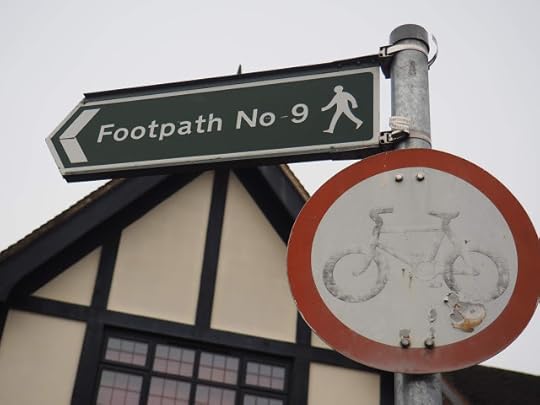
I went for a walk in Woodford with my friend Sue, who lives there but doesn’t like to be photographed (at least not from the front).

Down at the station there was Popeye,

and up on the Green there was Winston Churchill
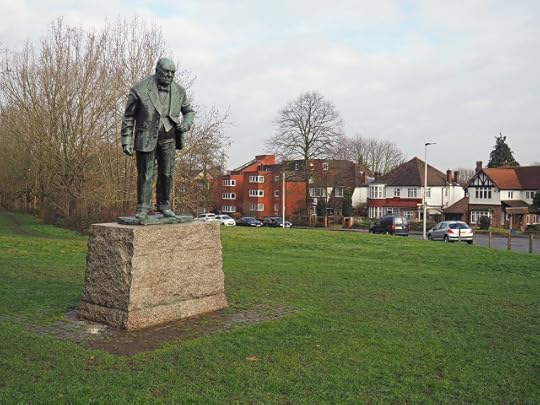
and in between there was much to fascinate the urban or suburban walker; this kind of thing:

But I had given myself a small mission, to see the house of James Hilton, the author of the novel Lost Horizon. He was living in Oak Hill Gardens when he wrote that book (now part of Woodford, but part Walthamstow at the time. He was also there when he wrote his other greatest hit Goodbye, Mr. Chips.

Now, I suspect few youngsters and even quite a few oldsters are unfamiliar with Lost Horizon although as you see, Hilton was once famous enough that his name was thought powerful enough to sell booze.
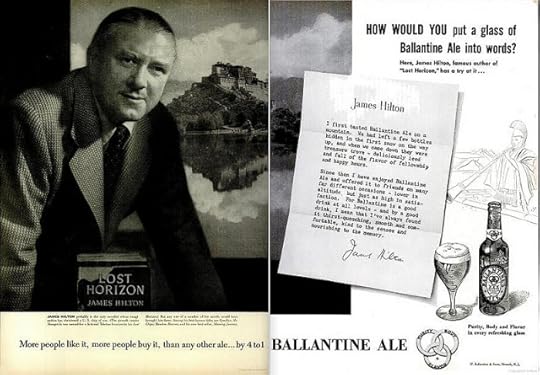
But everybody’s surely heard of Shangri-La, the mythical Tibetan kingdom run by lamas, where people can live to an unheard of great age. It’s still a surprisingly readable book - I just read it - and it seems extremely modern in a lot of respects. The sexual politics are inevitably a bit dodgy, the racial politics less dodgy than you might expect.
There’s a film too, starring Ronald Coleman as the heroic Conway, directed by Frank Capra, which is ruthlessly unfaithful to the original – the missionary from the novel becomes a floozy, Conway suddenly has a brother, and Edward Everett Horton pops up as a paleontologist.
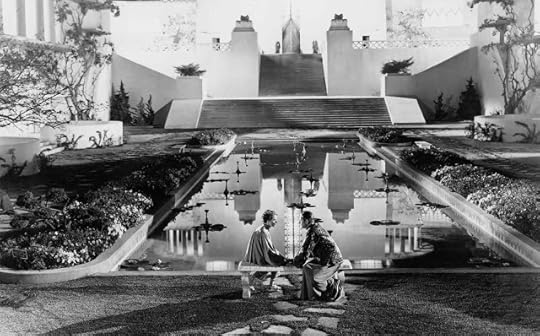
Actually there's a later film, a musical version (OMG), starring Peter Finch and Liv Ullman which is generally said to be cosmically awful.
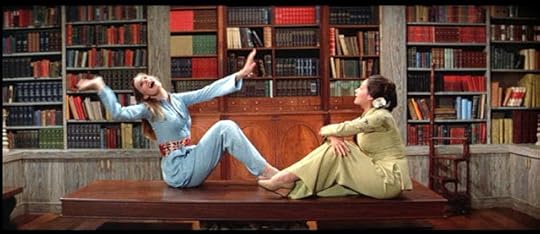
The book was written in the winter of 1932 when Hilton already knew that things were already looking bleak for the world, even from the suburban outpost in Walthamstow, and he imagined a place where a small pocket of civilization could survive however terrible the approaching cataclysm.
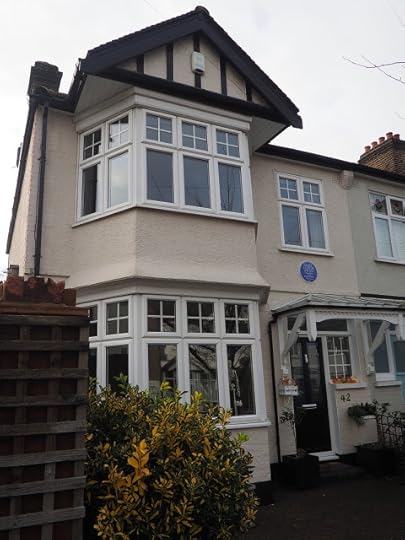
It wasn’t hard to find James Hilton’s house – it has a blue plaque, and whoever lives in the house now isn’t shy about expressing their personality. And if you look closely you can see a skeleton hanging in the front window. and it could be a leftover from Halloween but since my visit was in February they’ve obviously grown fond of having it around. Their mailbox, if that's what is, is impressive too.
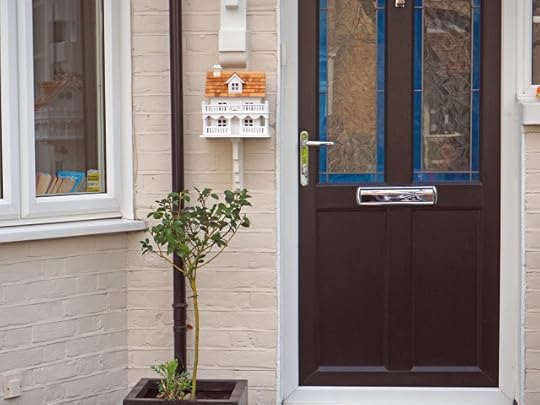
Woodford is about as suburban and respectable a place as you can imagine, and although I haven’t been able to find any comments Hilton made about the place, his description of Shangri-La seems extraordinary sounds very much like Middle England.
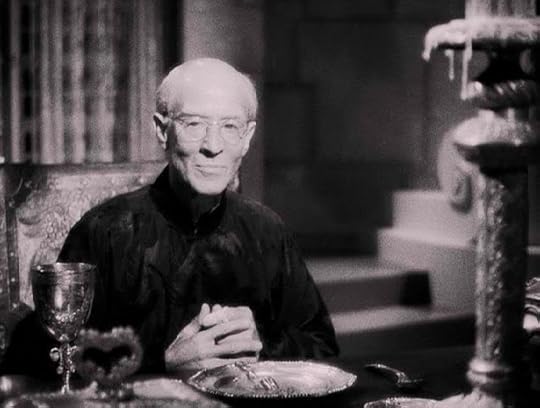
Chang explains how things are in Shangri-La: “If I were to put it into a very few words, my dear sir, I should say that our prevalent belief is in moderation. We inculcate the virtue of avoiding excesses of all kinds -even including, if you will pardon the paradox, excess of virtue itself … And I think I can claim that our people are moderately sober, moderately chaste and moderately honest.” This sounds more Church of England vicar than Tibetan lama.
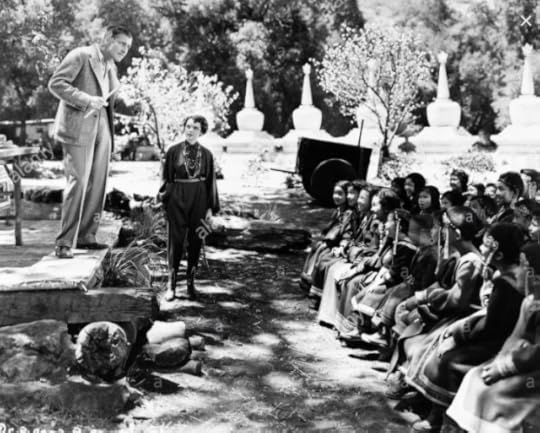
And Chang describes the lack of crime in Shangri-La, attributing it to the fact that only serious things were considered crimes and “partly because everyone enjoyed a sufficiency of everything he could reasonably desire.”
You think it’s starting to go off the rails a bit when Chang says, “You English inculcate the same feeling in your publics schools,” but then there’s a wonderful swerve, as he says, “but not I fear for the same things. The inhabitants of our valley, for instance feel that it is ‘not done’ to be inhospitable to strangers, to dispute acrimoniously, or to strive for priority amongst one another. The idea of enjoying what your English headmasters call the mimic warfare of the playing field would seem to them entirely barbarous, indeed, a sheer wanton simulation of all the lower instincts.” By which I suppose we can assume Hilton wasn’t good at sports.
Hilton became a very successful Hollywood screen writer and moved to California, where he won an Oscar for the script of Mrs. Miniver but interestingly (to me) he didn’t live in Beverley Hills or the Hollywood Hills where so many successful writers go; for the last ten years of his life (he died youngish, aged 54) he lived in Long Beach, in a bungalow on Argonne Avenue. I haven’t been able to find the number of the house, but part of the street looks like this on Streetview:
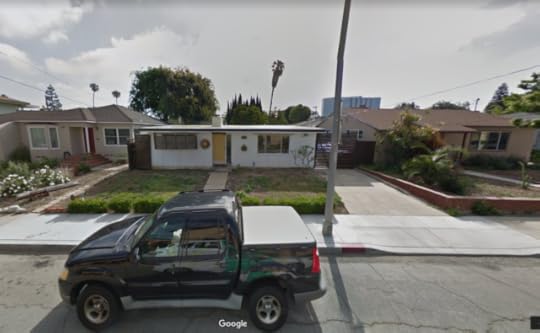
I’ve certainly walked around in Long Beach, though not down Argonne Street, and it’s a very different kind of suburbia from Woodford (or Walthamstow), but it’s still a member of the species.
Even at the time it evidently seemed an odd place for an Oscar-winning writer to make his home and Hilton was happy to explain in an interview: “I want to live in America. I want to write about it. You can’t get the feel of the country from Hollywood, so I came to Long Beach.”Perhaps the same could be said about England and Woodford. Depending on how you slice it, Hilton either came a long way or not very far at all. That horizon wasn’t so lost, or distant, after all.

Published on February 14, 2019 11:32
February 9, 2019
POUNDING DOWN IN POUNDBURY
I went for a walk in Poundbury, in Dorset. It wasn’t completely awful but it was weird, and in fact bits of it were pretty awful.
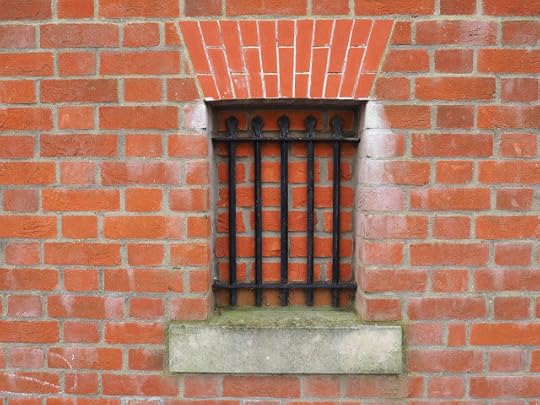
Poundbury, you know, is Prince Charles’s utopian stab at urban development, planned by his tame architectural theorist Leon Krier. Neither of these dudes lives in Poundbury, you’ll be surprised to hear. Krier does drawings like this:
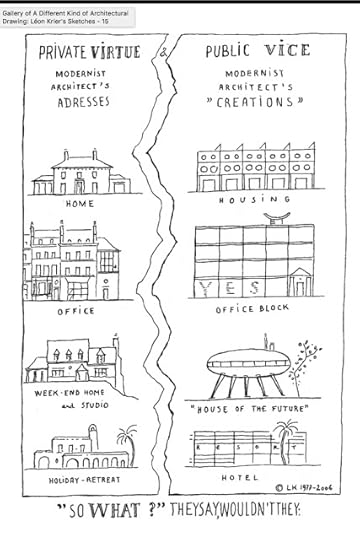
Poundbury gets compared to Disneyland and Stepford (where the wives comes from) but I kept thinking of The Prisoner - not the actual Portmeirion designed by Clough Williams-Ellis, the location where the tv show was filmed, but the fictional village – a place so calm and tranquil and well-ordered, you just knew something absolutely terrible was about to happen.
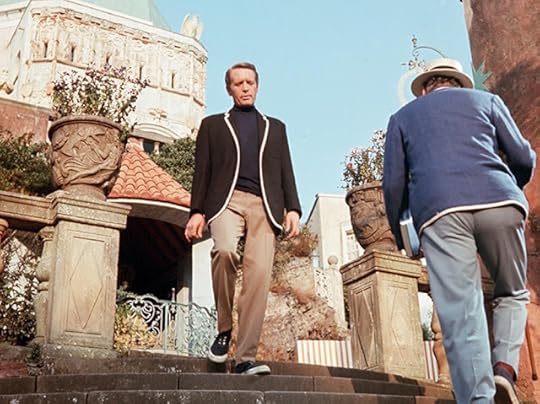
There is a town square of sorts in Poundbury, with a statue of the late Queen Mum – Krier designed the base.
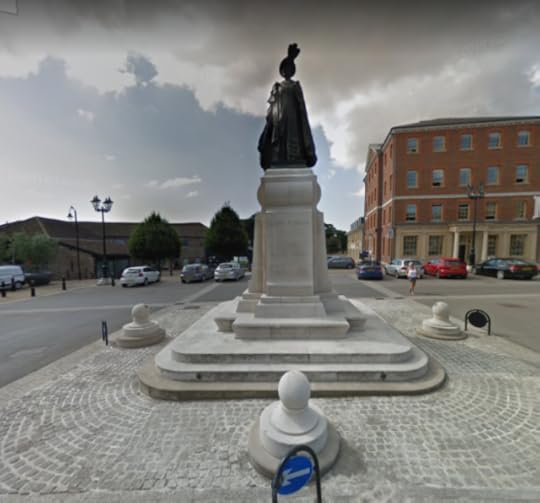
This is Queen Mother Square. Nearby is a pub named after Prince Charles’s wife - The Duchess of Cornwall Inn (what woman doesn’t want to have a pub name after her?), and just over the way, opposite the Waitrose, is a block of luxury flats that looks, deliberately, like a faux Buckingham Place, because you know, the real original Buckingham Place looks so awesome.
Incidentally, as you see, there is no grass in this public square, no benches, no identifiable pavements, nowhere to hang out. There is also very little separation between pedestrians and cars, though there are some bollards protecting the statue. They might also protect pedestrians, but that’s obviously not their prime reason for existing. The walker would do well to keep moving.
This lack of pedestrian friendliness comes as something of a surprise. Poundbury was supposedly built to be a super-pedestrian-friendly place. The Prince would have you believe he’s a great believer in walking. In 2004, he set down his ten design principles. Number five asks for: “The creation of well-designed enclosures. Rather than clusters of separate houses set at jagged angles, spaces that are bounded and enclosed by buildings are not only more visually satisfying, they encourage walking and feel safer.”

In this he’s echoing Leon Krier who posits a city made up of quarters or quadrants, the centers of which can be crossed in the course of a ten-minute walk. For most of us, that’s no more than a half-mile stroll, which seems a little unambitious, and just pitiful for anybody who enjoys walking in a big city.

In fact one of the first things this walker noticed was just how car-friendly Poundbury seemed, perhaps because, at the moment there’s a great deal of free parking. However, since the population is scheduled to double in size in the next few years, a parking spot adjacent to the Princess of Wales Inn may be increasingly hard to come by.
Along with this, I noticed just how many garages there are in Poundbury – huge numbers, most of them not attached to the dwelling of the car owner. In fact there were quite a few examples of flats built on top of one or more garages belonging to other people, the disadvantage of which seem utterly obvious.

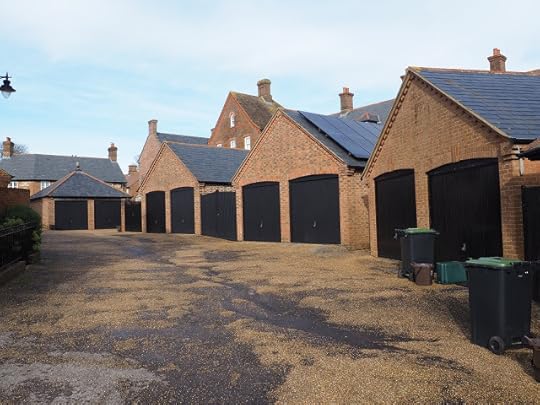
There are a few exceptions, but the vast majority of the garage doors are painted plain black. Now, I’m not suggesting than selecting the paint color for your garage door is an inalienable freedom or a great mark of self-expression, but my own feeling is that I’d prefer any color so long as it’s not plain black. I also thought those plain black “canvases” might represent a challenge and a provocation to the youth of Poundbury, but apparently not, and that may be because Poundbury the youth is in such short supply.
Of course I saw other people walking, some with dogs.
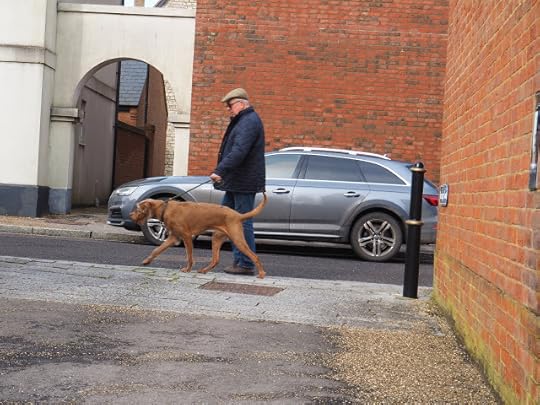
One woman with a Highgrove bag
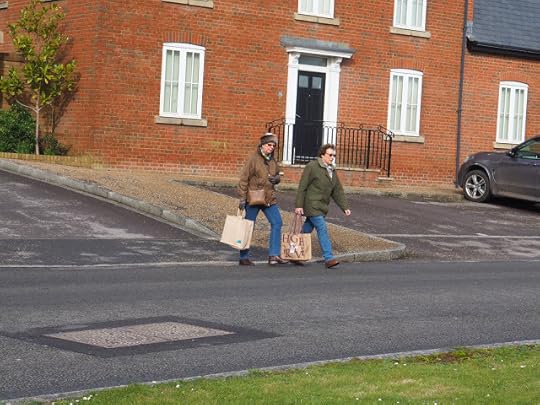
I also saw a couple of cats, of which this is one
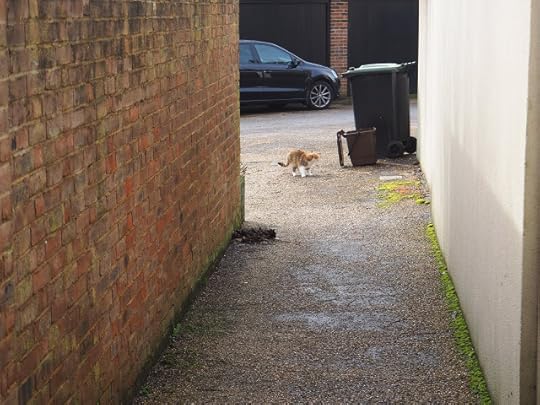
The place was clean, it was safe, it was nice, and I’m not an idiot, I’m not against any of those things,
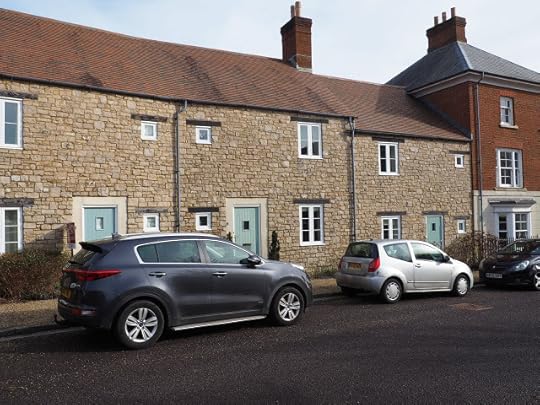
but oh boy did my heart leap up when I eventually found the council estate.
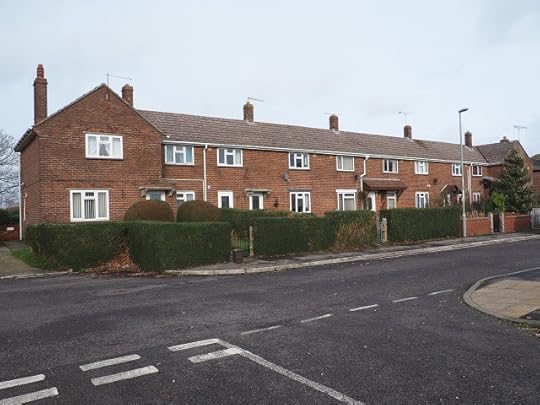
The only graffiti I saw were there or thereabouts, and I’m no snowflake when It comes to graffiti, and these was pretty rubbish in themselves but they came as a kind of relief.

These acts of self-expression were on one side of this classical temple type thing, which was actually an electricity substation.
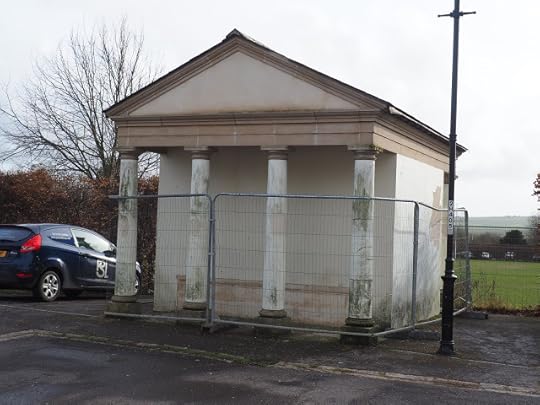
The garffiti were on the side that looked towards the sports ground and away from the council estate, which I suppose was basicially a good thing. And this “social housing” had so much that Poundbury houses didn’t have: life, an unruliness, a genuine if sometimes naff urge for eccentricity and self-expression. There were front gardens for instance – there were very few of those in Poundbury proper.
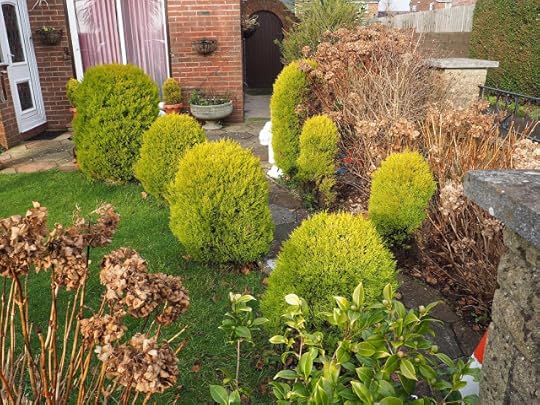
Here, some of them had been paved over to accommodate a car, some were carefully tended with topiary, some had am ugly heap of rubbish on the grass but at least the residents had made their own choice of paint color for the garage doors.
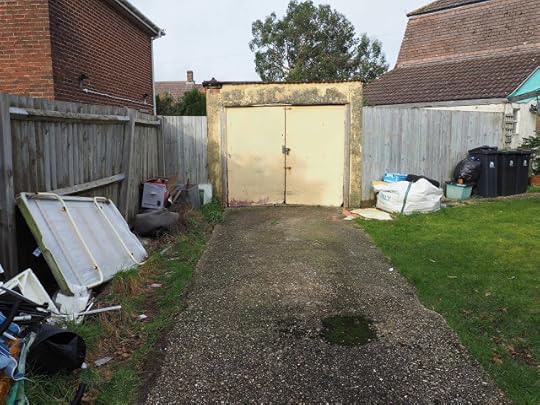
But the thing that made the whole Poundbury walking expedition worthwhile for me, was this sign in tha front garden of a house evidently belonging to a small local businessman.

Just possibly Poundbury is more diverse than many people think, or want it to be.


Poundbury, you know, is Prince Charles’s utopian stab at urban development, planned by his tame architectural theorist Leon Krier. Neither of these dudes lives in Poundbury, you’ll be surprised to hear. Krier does drawings like this:

Poundbury gets compared to Disneyland and Stepford (where the wives comes from) but I kept thinking of The Prisoner - not the actual Portmeirion designed by Clough Williams-Ellis, the location where the tv show was filmed, but the fictional village – a place so calm and tranquil and well-ordered, you just knew something absolutely terrible was about to happen.

There is a town square of sorts in Poundbury, with a statue of the late Queen Mum – Krier designed the base.

This is Queen Mother Square. Nearby is a pub named after Prince Charles’s wife - The Duchess of Cornwall Inn (what woman doesn’t want to have a pub name after her?), and just over the way, opposite the Waitrose, is a block of luxury flats that looks, deliberately, like a faux Buckingham Place, because you know, the real original Buckingham Place looks so awesome.
Incidentally, as you see, there is no grass in this public square, no benches, no identifiable pavements, nowhere to hang out. There is also very little separation between pedestrians and cars, though there are some bollards protecting the statue. They might also protect pedestrians, but that’s obviously not their prime reason for existing. The walker would do well to keep moving.
This lack of pedestrian friendliness comes as something of a surprise. Poundbury was supposedly built to be a super-pedestrian-friendly place. The Prince would have you believe he’s a great believer in walking. In 2004, he set down his ten design principles. Number five asks for: “The creation of well-designed enclosures. Rather than clusters of separate houses set at jagged angles, spaces that are bounded and enclosed by buildings are not only more visually satisfying, they encourage walking and feel safer.”

In this he’s echoing Leon Krier who posits a city made up of quarters or quadrants, the centers of which can be crossed in the course of a ten-minute walk. For most of us, that’s no more than a half-mile stroll, which seems a little unambitious, and just pitiful for anybody who enjoys walking in a big city.

In fact one of the first things this walker noticed was just how car-friendly Poundbury seemed, perhaps because, at the moment there’s a great deal of free parking. However, since the population is scheduled to double in size in the next few years, a parking spot adjacent to the Princess of Wales Inn may be increasingly hard to come by.
Along with this, I noticed just how many garages there are in Poundbury – huge numbers, most of them not attached to the dwelling of the car owner. In fact there were quite a few examples of flats built on top of one or more garages belonging to other people, the disadvantage of which seem utterly obvious.


There are a few exceptions, but the vast majority of the garage doors are painted plain black. Now, I’m not suggesting than selecting the paint color for your garage door is an inalienable freedom or a great mark of self-expression, but my own feeling is that I’d prefer any color so long as it’s not plain black. I also thought those plain black “canvases” might represent a challenge and a provocation to the youth of Poundbury, but apparently not, and that may be because Poundbury the youth is in such short supply.
Of course I saw other people walking, some with dogs.

One woman with a Highgrove bag

I also saw a couple of cats, of which this is one

The place was clean, it was safe, it was nice, and I’m not an idiot, I’m not against any of those things,

but oh boy did my heart leap up when I eventually found the council estate.

The only graffiti I saw were there or thereabouts, and I’m no snowflake when It comes to graffiti, and these was pretty rubbish in themselves but they came as a kind of relief.

These acts of self-expression were on one side of this classical temple type thing, which was actually an electricity substation.

The garffiti were on the side that looked towards the sports ground and away from the council estate, which I suppose was basicially a good thing. And this “social housing” had so much that Poundbury houses didn’t have: life, an unruliness, a genuine if sometimes naff urge for eccentricity and self-expression. There were front gardens for instance – there were very few of those in Poundbury proper.

Here, some of them had been paved over to accommodate a car, some were carefully tended with topiary, some had am ugly heap of rubbish on the grass but at least the residents had made their own choice of paint color for the garage doors.

But the thing that made the whole Poundbury walking expedition worthwhile for me, was this sign in tha front garden of a house evidently belonging to a small local businessman.

Just possibly Poundbury is more diverse than many people think, or want it to be.

Published on February 09, 2019 14:38
POUNDING IN POUNDBURY
I went for a walk in Poundbury, in Dorset. It wasn’t completely awful but it was weird, and in fact bits of it were pretty awful.

Poundbury, you know, is Prince Charles’s utopian stab at urban development, planned by his tame architectural theorist Leon Krier. Neither of these dudes lives in Poundbury, you’ll be surprised to hear. Krier does drawings like this:

Poundbury gets compared to Disneyland and Stepford (where the wives comes from) but I kept thinking of The Prisoner - not the actual Portmeirion designed by Clough Williams-Ellis, the location where the tv show was filmed, but the fictional village – a place so calm and tranquil and well-ordered, you just knew something absolutely terrible was about to happen.

There is a town square of sorts in Poundbury, with a statue of the late Queen Mum – Krier designed the base.

This is Queen Mother Square. Nearby is a pub named after Prince Charles’s wife - The Duchess of Cornwall Inn (what woman doesn’t want to have a pub name after her?), and just over the way, opposite the Waitrose, is a block of luxury flats that looks, deliberately, like a faux Buckingham Place, because you know, the real original Buckingham Place looks so awesome.
Incidentally, as you see, there is no grass in this public square, no benches, no identifiable pavements, nowhere to hang out. There is also very little separation between pedestrians and cars, though there are some bollards protecting the statue. They might also protect pedestrians, but that’s obviously not their prime reason for existing. The walker would do well to keep moving.
This lack of pedestrian friendliness comes as something of a surprise. Poundbury was supposedly built to be a super-pedestrian-friendly place. The Prince would have you believe he’s a great believer in walking. In 2004, he set down his ten design principles. Number five asks for: “The creation of well-designed enclosures. Rather than clusters of separate houses set at jagged angles, spaces that are bounded and enclosed by buildings are not only more visually satisfying, they encourage walking and feel safer.”

In this he’s echoing Leon Krier who posits a city made up of quarters or quadrants, the centers of which can be crossed in the course of a ten-minute walk. For most of us, that’s no more than a half-mile stroll, which seems a little unambitious, and just pitiful for anybody who enjoys walking in a big city.

In fact one of the first things this walker noticed was just how car-friendly Poundbury seemed, perhaps because, at the moment there’s a great deal of free parking. However, since the population is scheduled to double in size in the next few years, a parking spot adjacent to the Princess of Wales Inn may be increasingly hard to come by.
Along with this, I noticed just how many garages there are in Poundbury – huge numbers, most of them not attached to the dwelling of the car owner. In fact there were quite a few examples of flats built on top of one or more garages belonging to other people, the disadvantage of which seem utterly obvious.


There are a few exceptions, but the vast majority of the garage doors are painted plain black. Now, I’m not suggesting than selecting the paint color for your garage door is an inalienable freedom or a great mark of self-expression, but my own feeling is that I’d prefer any color so long as it’s not plain black. I also thought those plain black “canvases” might represent a challenge and a provocation to the youth of Poundbury, but apparently not, and that may be because Poundbury the youth is in such short supply.
Of course I saw other people walking, some with dogs.

One woman with a Highgrove bag

I also saw a couple of cats, of which this is one

The place was clean, it was safe, it was nice, and I’m not an idiot, I’m not against any of those things,

but oh boy did my heart leap up when I eventually found the council estate.

The only graffiti I saw were there or thereabouts, and I’m no snowflake when It comes to graffiti, and these was pretty rubbish in themselves but they came as a kind of relief.

These acts of self-expression were on one side of this classical temple type thing, which was actually an electricity substation.

The garffiti were on the side that looked towards the sports ground and away from the council estate, which I suppose was basicially a good thing. And this “social housing” had so much that Poundbury houses didn’t have: life, an unruliness, a genuine if sometimes naff urge for eccentricity and self-expression. There were front gardens for instance – there were very few of those in Poundbury proper.

Here, some of them had been paved over to accommodate a car, some were carefully tended with topiary, some had am ugly heap of rubbish on the grass but at least the residents had made their own choice of paint color for the garage doors.

But the thing that made the whole Poundbury walking expedition worthwhile for me, was this sign in tha front garden of a house evidently belonging to a small local businessman.

Just possibly Poundbury is more diverse than many people think, or want it to be.


Poundbury, you know, is Prince Charles’s utopian stab at urban development, planned by his tame architectural theorist Leon Krier. Neither of these dudes lives in Poundbury, you’ll be surprised to hear. Krier does drawings like this:

Poundbury gets compared to Disneyland and Stepford (where the wives comes from) but I kept thinking of The Prisoner - not the actual Portmeirion designed by Clough Williams-Ellis, the location where the tv show was filmed, but the fictional village – a place so calm and tranquil and well-ordered, you just knew something absolutely terrible was about to happen.

There is a town square of sorts in Poundbury, with a statue of the late Queen Mum – Krier designed the base.

This is Queen Mother Square. Nearby is a pub named after Prince Charles’s wife - The Duchess of Cornwall Inn (what woman doesn’t want to have a pub name after her?), and just over the way, opposite the Waitrose, is a block of luxury flats that looks, deliberately, like a faux Buckingham Place, because you know, the real original Buckingham Place looks so awesome.
Incidentally, as you see, there is no grass in this public square, no benches, no identifiable pavements, nowhere to hang out. There is also very little separation between pedestrians and cars, though there are some bollards protecting the statue. They might also protect pedestrians, but that’s obviously not their prime reason for existing. The walker would do well to keep moving.
This lack of pedestrian friendliness comes as something of a surprise. Poundbury was supposedly built to be a super-pedestrian-friendly place. The Prince would have you believe he’s a great believer in walking. In 2004, he set down his ten design principles. Number five asks for: “The creation of well-designed enclosures. Rather than clusters of separate houses set at jagged angles, spaces that are bounded and enclosed by buildings are not only more visually satisfying, they encourage walking and feel safer.”

In this he’s echoing Leon Krier who posits a city made up of quarters or quadrants, the centers of which can be crossed in the course of a ten-minute walk. For most of us, that’s no more than a half-mile stroll, which seems a little unambitious, and just pitiful for anybody who enjoys walking in a big city.

In fact one of the first things this walker noticed was just how car-friendly Poundbury seemed, perhaps because, at the moment there’s a great deal of free parking. However, since the population is scheduled to double in size in the next few years, a parking spot adjacent to the Princess of Wales Inn may be increasingly hard to come by.
Along with this, I noticed just how many garages there are in Poundbury – huge numbers, most of them not attached to the dwelling of the car owner. In fact there were quite a few examples of flats built on top of one or more garages belonging to other people, the disadvantage of which seem utterly obvious.


There are a few exceptions, but the vast majority of the garage doors are painted plain black. Now, I’m not suggesting than selecting the paint color for your garage door is an inalienable freedom or a great mark of self-expression, but my own feeling is that I’d prefer any color so long as it’s not plain black. I also thought those plain black “canvases” might represent a challenge and a provocation to the youth of Poundbury, but apparently not, and that may be because Poundbury the youth is in such short supply.
Of course I saw other people walking, some with dogs.

One woman with a Highgrove bag

I also saw a couple of cats, of which this is one

The place was clean, it was safe, it was nice, and I’m not an idiot, I’m not against any of those things,

but oh boy did my heart leap up when I eventually found the council estate.

The only graffiti I saw were there or thereabouts, and I’m no snowflake when It comes to graffiti, and these was pretty rubbish in themselves but they came as a kind of relief.

These acts of self-expression were on one side of this classical temple type thing, which was actually an electricity substation.

The garffiti were on the side that looked towards the sports ground and away from the council estate, which I suppose was basicially a good thing. And this “social housing” had so much that Poundbury houses didn’t have: life, an unruliness, a genuine if sometimes naff urge for eccentricity and self-expression. There were front gardens for instance – there were very few of those in Poundbury proper.

Here, some of them had been paved over to accommodate a car, some were carefully tended with topiary, some had am ugly heap of rubbish on the grass but at least the residents had made their own choice of paint color for the garage doors.

But the thing that made the whole Poundbury walking expedition worthwhile for me, was this sign in tha front garden of a house evidently belonging to a small local businessman.

Just possibly Poundbury is more diverse than many people think, or want it to be.

Published on February 09, 2019 14:38
NATURALLY
Well they certainly do look like they're having fun.
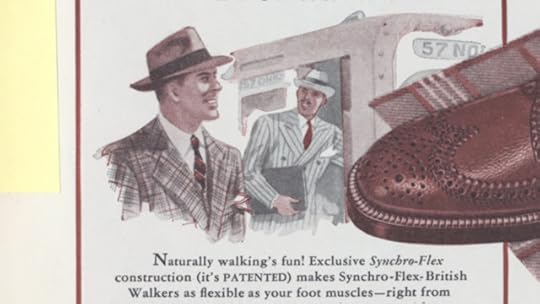
And Britishness is invoked, since the British certainly do know how to have fun.

Published on February 09, 2019 02:01
February 5, 2019
MEAN STREETS, I SUPPOSE
I’ve been reading a rather good book titled A Spy’s London, by Roy Berkeley. It’s a sort of travel book and walking guide, complete with maps, that allows you to wander around London and see where various spies lived, and where various acts of espionage were planned or committed. Chelsea is full of them, it seems.

There’s 111, Old Church Street where the SIS trained refugees from Estonia, Latvia and Lithuania, and turned them into secret agents. There’s the flat in Drayton Gardens where Kim Philby lived with his mother. And there’s the home of Ian Fleming in Carlyle Mansions, Cheyne Walk.
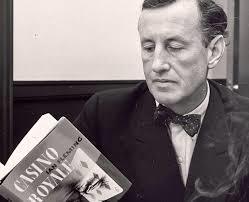 Authors just love to pose as though they're reading their own books.
Authors just love to pose as though they're reading their own books.
Berkeley, like many before him, is skeptical about the extent of Fleming’s work as a spy, and calls him an intelligence wannabe. Fleming moved into Carlyle Mansions in 1952, taking his gold typewriter with him, bought specially to finish Casino Royale.
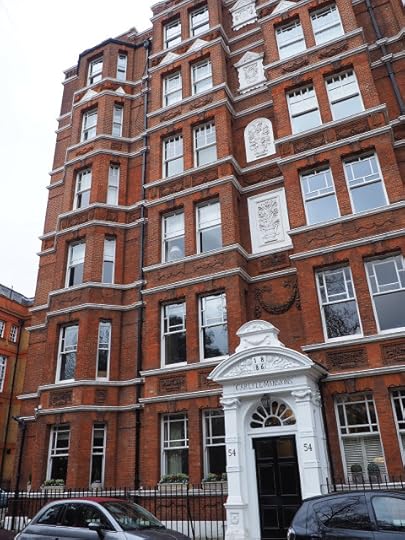
Fleming’s flat was some floors above TS Eliot who, as I understand it, was living there at the time, at number 19, in an austere room, its walls bare except for a crucifix, and Eliot himself was living immediately beneath a flat where Henry James had lived.

If the internet is to be believed, number 19 was subsequently the place where the serial killer Patrick Mackay murdered an elderly widow named Isabella Griffiths in 1974. ("There will be time to murder and create")
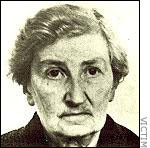
A more optimistic confluence has it that in 1958 Raymond Chandler was living very close to Cheyne Walk, in Swan Walk. He was in desperate straits, grieving for his late wife, drinking too much, and working on his last, unfinished, and doomed Marlowe novel, Poodle Springs. It seems that Fleming lived in a considerably better building, but Chandler was only staying for one summer.
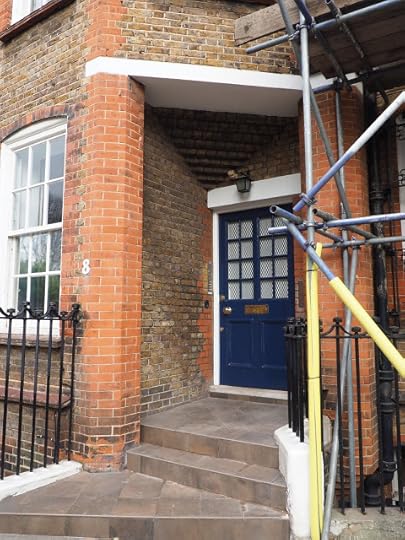
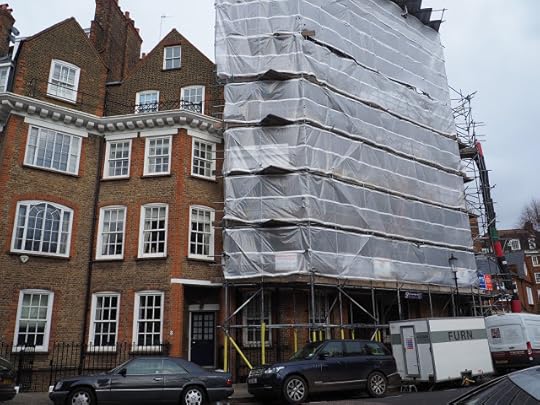
I think it’s unlikely that Chandler and Fleming ever walked to each other’s flat. I did, of course, and then back again. On the way I passed a door to The London Sketch Club,
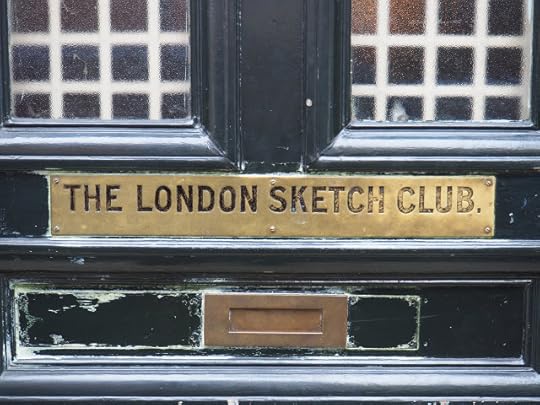
and I walked by Clover Mews, “This is a PRIVATE Mews”
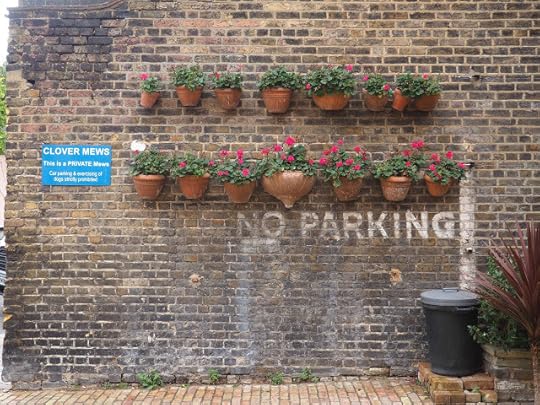
Frankly, it didn’t feel much like Bond territory, and understandably it felt even less like Marlowe territory.
But Chandler and Fleming did have at least one encounter, not in the street while walking, but in a broadcast they did together on BBC radio in 1958 – Chandler was 70, Fleming 50 - and Fleming adopts the position of the junior partner, very wise given than Chandler (who of course I love more than life itself) sounds in the broadcast to be a bit of cantankerous old know it all, and very possibly drunk. Thus:
Fleming: I see they had another killing last week in New York. One of these men connected with that dock union man—what’s his name?Chandler: Albert Anastasia?Fleming: Anastasia, yes. How’s a killing like that arranged?Chandler: Very simply. You want me to describe how it’s done?Fleming: Yes, yes.Chandler: ... So they go to where the man lives, and they get an apartment or a room across the street from him. They study him for days and days and days until they know exactly when he goes out, and when he comes home, what he does. And when they’re ready, they simply walk up to him and shoot him.
Walking, it’s not for wimps.


There’s 111, Old Church Street where the SIS trained refugees from Estonia, Latvia and Lithuania, and turned them into secret agents. There’s the flat in Drayton Gardens where Kim Philby lived with his mother. And there’s the home of Ian Fleming in Carlyle Mansions, Cheyne Walk.
 Authors just love to pose as though they're reading their own books.
Authors just love to pose as though they're reading their own books.Berkeley, like many before him, is skeptical about the extent of Fleming’s work as a spy, and calls him an intelligence wannabe. Fleming moved into Carlyle Mansions in 1952, taking his gold typewriter with him, bought specially to finish Casino Royale.

Fleming’s flat was some floors above TS Eliot who, as I understand it, was living there at the time, at number 19, in an austere room, its walls bare except for a crucifix, and Eliot himself was living immediately beneath a flat where Henry James had lived.

If the internet is to be believed, number 19 was subsequently the place where the serial killer Patrick Mackay murdered an elderly widow named Isabella Griffiths in 1974. ("There will be time to murder and create")

A more optimistic confluence has it that in 1958 Raymond Chandler was living very close to Cheyne Walk, in Swan Walk. He was in desperate straits, grieving for his late wife, drinking too much, and working on his last, unfinished, and doomed Marlowe novel, Poodle Springs. It seems that Fleming lived in a considerably better building, but Chandler was only staying for one summer.


I think it’s unlikely that Chandler and Fleming ever walked to each other’s flat. I did, of course, and then back again. On the way I passed a door to The London Sketch Club,

and I walked by Clover Mews, “This is a PRIVATE Mews”

Frankly, it didn’t feel much like Bond territory, and understandably it felt even less like Marlowe territory.
But Chandler and Fleming did have at least one encounter, not in the street while walking, but in a broadcast they did together on BBC radio in 1958 – Chandler was 70, Fleming 50 - and Fleming adopts the position of the junior partner, very wise given than Chandler (who of course I love more than life itself) sounds in the broadcast to be a bit of cantankerous old know it all, and very possibly drunk. Thus:
Fleming: I see they had another killing last week in New York. One of these men connected with that dock union man—what’s his name?Chandler: Albert Anastasia?Fleming: Anastasia, yes. How’s a killing like that arranged?Chandler: Very simply. You want me to describe how it’s done?Fleming: Yes, yes.Chandler: ... So they go to where the man lives, and they get an apartment or a room across the street from him. They study him for days and days and days until they know exactly when he goes out, and when he comes home, what he does. And when they’re ready, they simply walk up to him and shoot him.
Walking, it’s not for wimps.

Published on February 05, 2019 05:16
January 30, 2019
SUBURBAN STROLLS
 The best photo I can find of Tracey Thorne walking.Tracey Thorn is OK by me. She said some nice things about my book The Lost Art of Walking, and now she’s written a second memoir Another Planet: A Teenager in Suburbia, the title of which says it all, about growing up in Brookmans Park, a place I’d certainly never heard of. Unsurprisingly, as a teenager, she has arguments with her parents
The best photo I can find of Tracey Thorne walking.Tracey Thorn is OK by me. She said some nice things about my book The Lost Art of Walking, and now she’s written a second memoir Another Planet: A Teenager in Suburbia, the title of which says it all, about growing up in Brookmans Park, a place I’d certainly never heard of. Unsurprisingly, as a teenager, she has arguments with her parents“I told them I wanted to marry a poet and live in London. I wanted to get out. I couldn’t understand why they had ever moved here in the first place. Why would anyone want to? Who would choose suburbia? It’s for squares, for drones, worst of all, for PARENTS, who love it for the quality of life it offers. Young people don’t care about such things as comfort and cleanliness – they want culture, and nightlife, and energy. There are no clubs or pavement cafes in suburbia. You can’t explore it at night, as – say – Dickens walked the streets of London. Who walks around suburbia at night? You can’t be a suburban flâneur. Suburbia is for those who want a quiet life with no alarms or surprises. It goes to bed early, and after dark, when a teenager comes alive, the streets are silent.No wonder we looked at suburbia and wanted to burn it down.
I will say only a coupla things, that you can have better arguments with your parents even if you don’t live in suburbia, and even if you don’t want to marry a poet. I will also say that some of us do in fact enjoy being nocturnal, suburban flâneurs. And it’s not just me, it’s Jack Kerouac too, apparently, as here in The Dharma Bums
“Everything was fine with the Zen Lunatics, the nut wagon was too far away to hear us. But there was a wisdom in it all, as you'll see if you take a walk some night on a suburban street and pass house after house on both sides of the street each with the lamplight of the living room, shining golden, and inside the little blue square of the television, each living family riveting its attention on probably one show; nobody talking; silence in the yards; dogs barking at you because you pass on human feet instead of on wheels. You'll see what I mean, when it begins to appear like everybody in the world is soon going to be thinking the same way and the Zen Lunatics have long joined dust, laughter on their dust lips.”
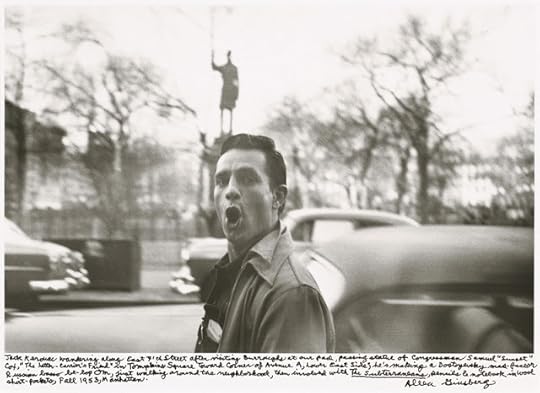 The best pictures I can find of Jack Kerouac walking. And yes, I do realize it's not night, and he's not in a suburb.
The best pictures I can find of Jack Kerouac walking. And yes, I do realize it's not night, and he's not in a suburb.Kerouac never married a poet but he did date and/or marry a lot of women who subsequently went on to write memoirs detailing what a shit he was.

Published on January 30, 2019 01:38
January 27, 2019
FARRELL AND FRIENDS
Long ago and far away, I moved into a flat in Maida Vale in West London. Naturally I walked around, explored the area, looked at things, and I came across a curious but intriguing house in Ashworth Road. I don’t absolutely remember how it looked, and I certainly wish I’d taken a picture, but I didn’t take many photographs back then - few did - but I seem to recall a fairly conventional house made rather wild with wonderful and colourful geometrical addictions. I’ve been searching for an image online but haven’t been able to find one (perhaps somebody can supply - Hi Terry!), though I did find a couple of pictures of the interior, which obviously I never saw back then.

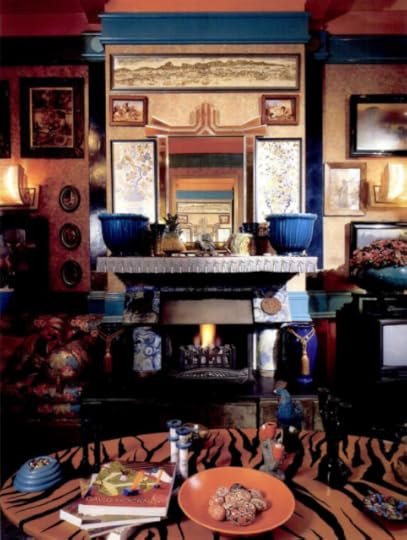
I soon worked out that the house belonged to the architect Terry Farrell, a name I barely knew at the time, though I did know a couple of his buildings. The Clifton Nursery in Covent Garden:

And the TV-am building in Camden, with the egg cups, one of which now resides in the John Soane Museum.
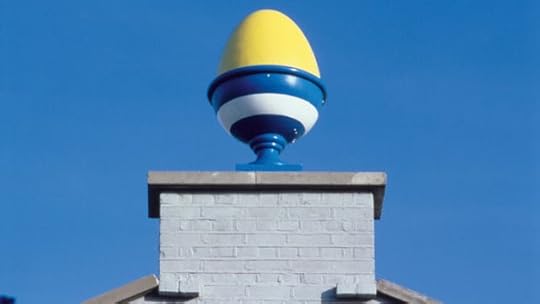
While searching for a picture of the outside of the Ashworth Road house I did find these words written by the man himself,“Reflecting on my own experience at my house in Ashworth Road, Maida Vale – built among the lavender fields in the 1920s and connected with Central London by the Bakerloo line – I realized that the way I occupied it and changed it and turned it around over the years was all about making a city, a world inside my own home. But equally the city reflects in its streets the halls and corridors and circulation of a house.”
I think I know what he means, although given how few Londoners occupy entire houses, and given that you can easily pay 3 or 4 million quid for a house in Ashworth Road, it may not be an experience that many of us can share directly. And I had never previously heard about the lavender fields.
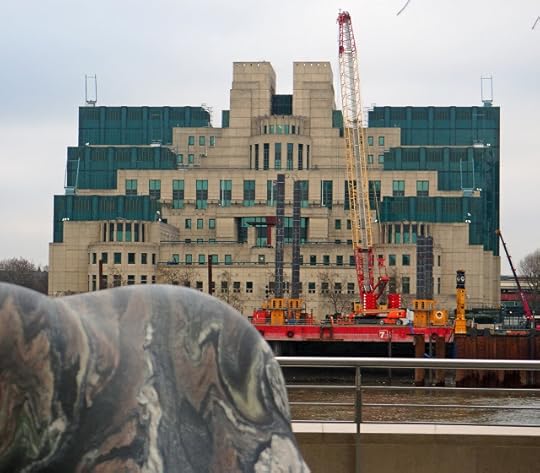
Farrell, of course, went on to design the MI6 (or SIS) Building in Vauxhall - a building which achieves of the considerable feat of looking both forbidding and playful at the same time, and also gloriously, defiantly conspicuous – a case of hiding in plain sight if ever there was one.
I happened to walk around the outside of it last week, and I must say it looks a lot less playful when seen up close. Yes, there are a few postmodern touches. like these quasi, or possibly faux, buttresses that are vaguely reminiscent of Frank Lloyd Wright:
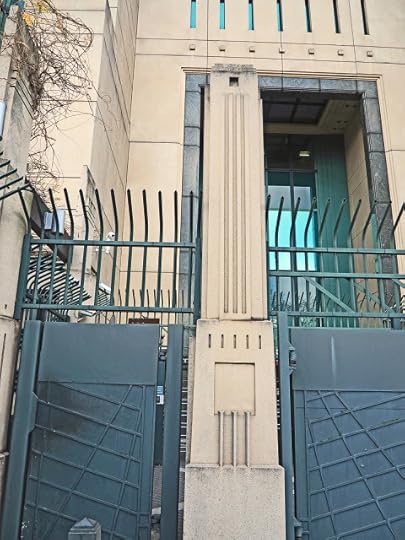
But chiefly you notice there are various kinds of evil looking fences, spikes and barbs to keep you out. And security cameras too, of course.
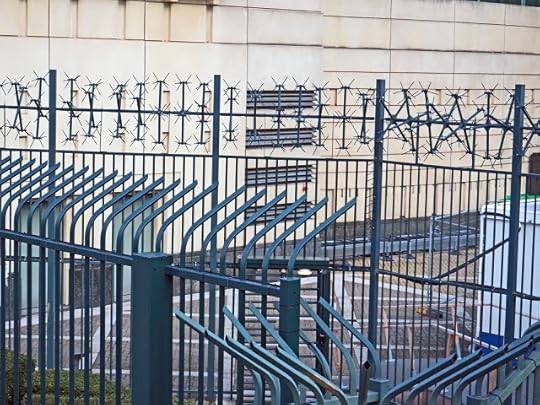
These things are certainly a deterrent but I wonder how many miscreants walking past that fortress would feel the urge to break in, even if there were no deterrents at all.
Also, being a skeptic, I couldn’t help thinking these things might just be there just for show, a kind of theater or set dressing, and maybe the place was empty and all the spies were actually in an unmarked building in Billericay or some such place.
And the impending sense that all might not be quite as it appears (which arguably is as it should be with spycraft) was reinforced by these three lads on the adjacent building site by the river, lolling against the security fence and sitting on the steps of perimeter of the MI6 building.
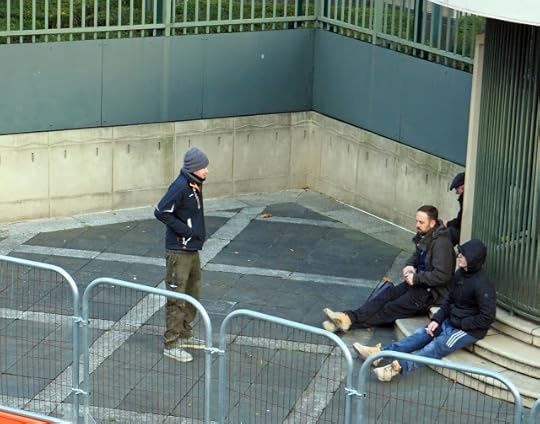
True, they didn’t look like a threat to national security, but all the same you’d have thought that a polite, anonymous fellow from Intelligence might have popped out and had a quiet but firm word with them.
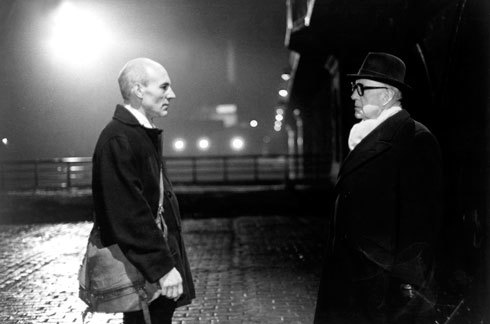
I gather that Terry Farrell now lives in a former Spitfire factory in Marylebone, and seems to be something of a cactus fancier, so he can’t be all bad.
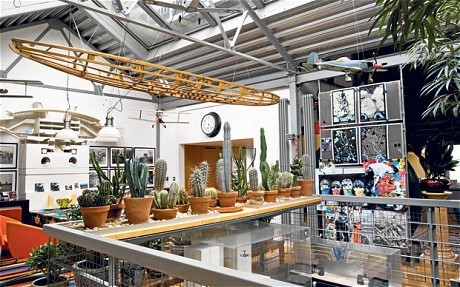



I soon worked out that the house belonged to the architect Terry Farrell, a name I barely knew at the time, though I did know a couple of his buildings. The Clifton Nursery in Covent Garden:

And the TV-am building in Camden, with the egg cups, one of which now resides in the John Soane Museum.

While searching for a picture of the outside of the Ashworth Road house I did find these words written by the man himself,“Reflecting on my own experience at my house in Ashworth Road, Maida Vale – built among the lavender fields in the 1920s and connected with Central London by the Bakerloo line – I realized that the way I occupied it and changed it and turned it around over the years was all about making a city, a world inside my own home. But equally the city reflects in its streets the halls and corridors and circulation of a house.”
I think I know what he means, although given how few Londoners occupy entire houses, and given that you can easily pay 3 or 4 million quid for a house in Ashworth Road, it may not be an experience that many of us can share directly. And I had never previously heard about the lavender fields.

Farrell, of course, went on to design the MI6 (or SIS) Building in Vauxhall - a building which achieves of the considerable feat of looking both forbidding and playful at the same time, and also gloriously, defiantly conspicuous – a case of hiding in plain sight if ever there was one.
I happened to walk around the outside of it last week, and I must say it looks a lot less playful when seen up close. Yes, there are a few postmodern touches. like these quasi, or possibly faux, buttresses that are vaguely reminiscent of Frank Lloyd Wright:

But chiefly you notice there are various kinds of evil looking fences, spikes and barbs to keep you out. And security cameras too, of course.

These things are certainly a deterrent but I wonder how many miscreants walking past that fortress would feel the urge to break in, even if there were no deterrents at all.
Also, being a skeptic, I couldn’t help thinking these things might just be there just for show, a kind of theater or set dressing, and maybe the place was empty and all the spies were actually in an unmarked building in Billericay or some such place.
And the impending sense that all might not be quite as it appears (which arguably is as it should be with spycraft) was reinforced by these three lads on the adjacent building site by the river, lolling against the security fence and sitting on the steps of perimeter of the MI6 building.

True, they didn’t look like a threat to national security, but all the same you’d have thought that a polite, anonymous fellow from Intelligence might have popped out and had a quiet but firm word with them.

I gather that Terry Farrell now lives in a former Spitfire factory in Marylebone, and seems to be something of a cactus fancier, so he can’t be all bad.


Published on January 27, 2019 09:34
January 24, 2019
BIKINI WALKERS
Well, this was a sad and terrible thing. I had never heard of Gigi Wu while she was alive, but apparently she was well-known in some quarters as the “bikini hiker,” and now she’s dead.

Her “practice” was to walk, or trek, though not actually climb, up mountain peaks and then take a picture of herself wearing a bikini, or in these cases have somebody take it, I assume. She seems to have been very serious about the walking, but also a social media walker. The walk was nothing without the photograph and vice versa. She also, let’s face it, looked pretty good in a bikini.
Gigi Wu, was Taiwanese, and she died on a solo walk, falling into a ravine in Yushan National Park, also in Taiwan. She seems actually to have died of hypothermia. She managed to contact rescue services but they couldn’t get to her because of bad weather.
Her Instagram account which is tagged barefootbikinihiker is currently closed but they say it’ll be reopened as a memorial, once the funeral has taken place.
Incidentally if you type bikinihiker into Instagram or Google you’ll find that scores, maybe hundreds, maybe thousands of women are hiking in bikinis, including Ann Wheeler of Clayton-le-Woods, in Lancashire who is described thus by the Caters news agency: “A mum was inspired by a near-death experience to get ‘body confident’ and go on 20-mile hikes in just a BIKINI and boots – but jealous women have told their walker husbands to KEEP AWAY.”
 Ann Wheeler, with a friend
Ann Wheeler, with a friend
Ah men, ah women, ah news stories. Ann Wheeler was, and I suppose still is, suffering from Cauda Equina Syndrome, which is a monstrous thing caused by damage to nerves below the spinal column. Seems that its severity can vary enormously but you still have to admire someone who has that condition, and according to the reports, has done all 214 of Wainwright’s walks in the Lake District. The bikini only adds to the fun.

Her “practice” was to walk, or trek, though not actually climb, up mountain peaks and then take a picture of herself wearing a bikini, or in these cases have somebody take it, I assume. She seems to have been very serious about the walking, but also a social media walker. The walk was nothing without the photograph and vice versa. She also, let’s face it, looked pretty good in a bikini.
Gigi Wu, was Taiwanese, and she died on a solo walk, falling into a ravine in Yushan National Park, also in Taiwan. She seems actually to have died of hypothermia. She managed to contact rescue services but they couldn’t get to her because of bad weather.

Her Instagram account which is tagged barefootbikinihiker is currently closed but they say it’ll be reopened as a memorial, once the funeral has taken place.
Incidentally if you type bikinihiker into Instagram or Google you’ll find that scores, maybe hundreds, maybe thousands of women are hiking in bikinis, including Ann Wheeler of Clayton-le-Woods, in Lancashire who is described thus by the Caters news agency: “A mum was inspired by a near-death experience to get ‘body confident’ and go on 20-mile hikes in just a BIKINI and boots – but jealous women have told their walker husbands to KEEP AWAY.”
 Ann Wheeler, with a friend
Ann Wheeler, with a friendAh men, ah women, ah news stories. Ann Wheeler was, and I suppose still is, suffering from Cauda Equina Syndrome, which is a monstrous thing caused by damage to nerves below the spinal column. Seems that its severity can vary enormously but you still have to admire someone who has that condition, and according to the reports, has done all 214 of Wainwright’s walks in the Lake District. The bikini only adds to the fun.

Published on January 24, 2019 08:55
January 22, 2019
THE OBELISK MAN
Funny things, obsessions. Some of them last so much longer than others. Some wear off and are gone quite quickly. Some come and then go away for a while and then return. And in some cases it seems that the obsession is pursuing you, rather than the other way round.
And so I return to my mild, yet ongoing and very possibly expanding, interest in obelisks. I’ve written about them a couple of times before on this blog but I keep seeing them as a walk through the world, and this seems in some oblique way significant.

On the one hand obelisks may be seen light coming down from heaven and being focused rather precisely. On the other it’s seen a phallic symbol of male power. I really have no dog in that fight – although as phallic symbols go it seems a bit hard-edged. And when I see them on my travels I’m not sure I think of them as either. For me it’s more about variations within a definite form, as with the martini.
Towards the end of last year I was in Chicago. I didn’t go there looking for obelisks, I didn’t expect to see them, and yet Chicago seems to be Obelisk Central.
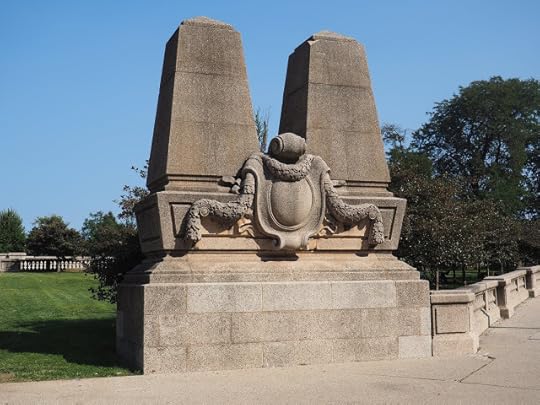
They’re all over the place. It has a lot to do with Frederick Law Olmsted who designed large chunks of the city, including parts of what’s apparently known as the "emerald necklace.” But it’s not restricted to that area.
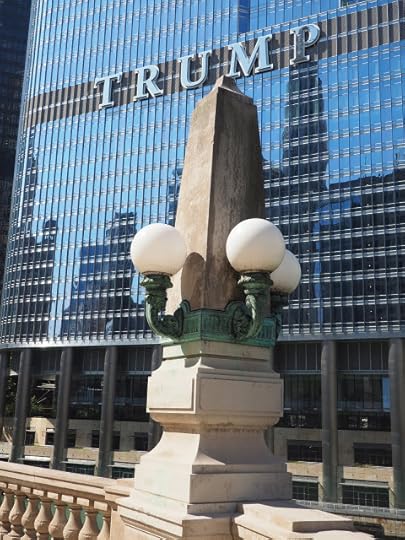
And taphophile that I am, I went to the cemetery named Graceland (no Elvis connection) which I’d read about on Atlas Obscura, and which I think they rather over-sold as featuring “magnificent opulence.” I’ve seen opulenter. But for me it was just the biggest cluster of obelisks I’d ever seen.
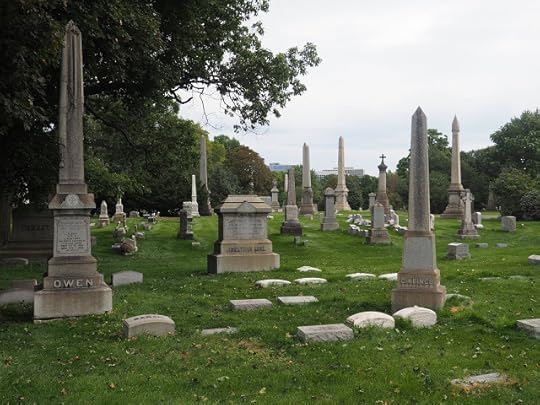
And then once I arrived in London I went to Brompton cemetery and there are lots of obelisks there too, though not nearly as many in Chicago:

And then in the deer park in Richmond
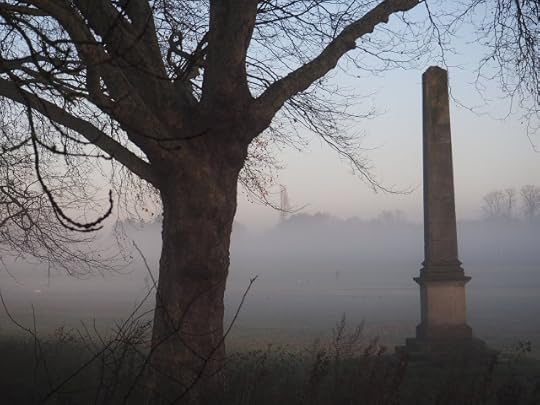
And on display in the British museum, which wasn’t really all that surprising
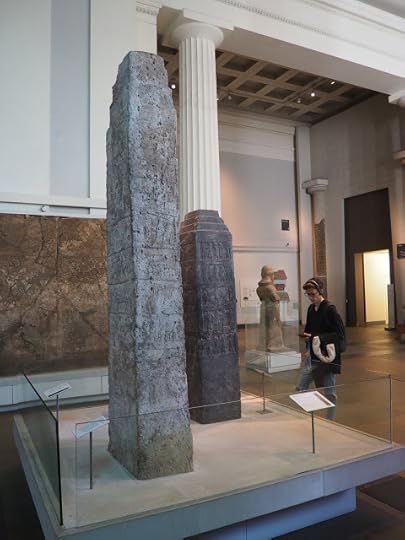
But there are also a couple tucked into corners in the Museum’s Great Court, which doesn’t seem very respectful.
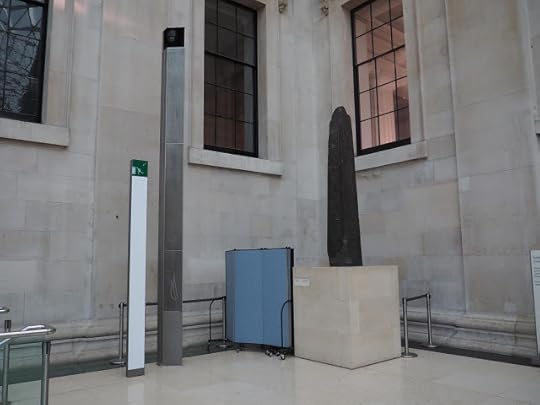
And there were some in a shop window opposite the British Museum – I guess if you can’t sell an obelisk there, you probably can’t sell one anywhere. That's the image at the top of this post. I bought one, naturally.
And then in Battersea Park at the weekend I saw a set of them by children’s zoo, unnoticed by the passing afternoon strollers.
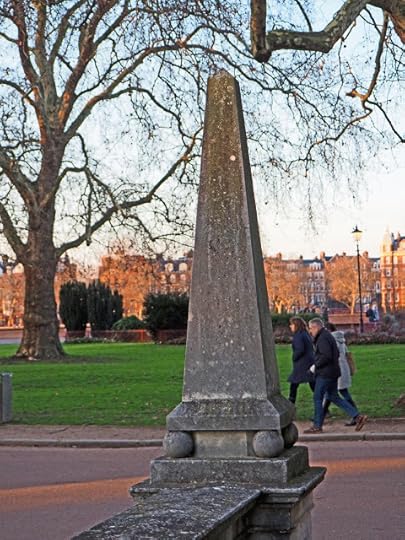
This is by no means a complete list of recent sightings. But here’s a thing; as I walked in the cemetery in Chicago I saw this:
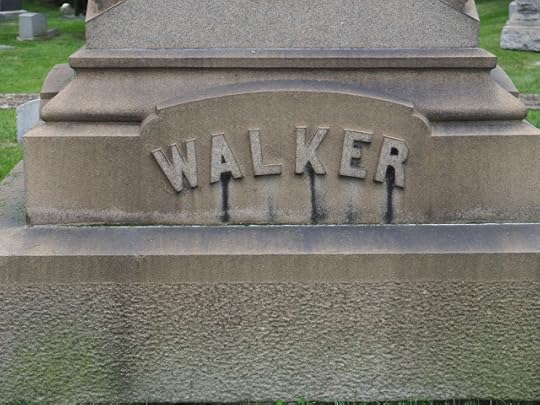
And as I walked in the Brompton I saw this:
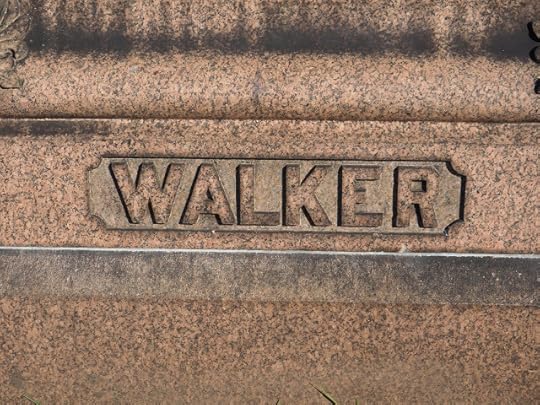
Walkers get everywhere, and most of us know a memento mori when we see one.


And so I return to my mild, yet ongoing and very possibly expanding, interest in obelisks. I’ve written about them a couple of times before on this blog but I keep seeing them as a walk through the world, and this seems in some oblique way significant.

On the one hand obelisks may be seen light coming down from heaven and being focused rather precisely. On the other it’s seen a phallic symbol of male power. I really have no dog in that fight – although as phallic symbols go it seems a bit hard-edged. And when I see them on my travels I’m not sure I think of them as either. For me it’s more about variations within a definite form, as with the martini.
Towards the end of last year I was in Chicago. I didn’t go there looking for obelisks, I didn’t expect to see them, and yet Chicago seems to be Obelisk Central.

They’re all over the place. It has a lot to do with Frederick Law Olmsted who designed large chunks of the city, including parts of what’s apparently known as the "emerald necklace.” But it’s not restricted to that area.

And taphophile that I am, I went to the cemetery named Graceland (no Elvis connection) which I’d read about on Atlas Obscura, and which I think they rather over-sold as featuring “magnificent opulence.” I’ve seen opulenter. But for me it was just the biggest cluster of obelisks I’d ever seen.

And then once I arrived in London I went to Brompton cemetery and there are lots of obelisks there too, though not nearly as many in Chicago:

And then in the deer park in Richmond

And on display in the British museum, which wasn’t really all that surprising

But there are also a couple tucked into corners in the Museum’s Great Court, which doesn’t seem very respectful.

And there were some in a shop window opposite the British Museum – I guess if you can’t sell an obelisk there, you probably can’t sell one anywhere. That's the image at the top of this post. I bought one, naturally.
And then in Battersea Park at the weekend I saw a set of them by children’s zoo, unnoticed by the passing afternoon strollers.

This is by no means a complete list of recent sightings. But here’s a thing; as I walked in the cemetery in Chicago I saw this:

And as I walked in the Brompton I saw this:

Walkers get everywhere, and most of us know a memento mori when we see one.


Published on January 22, 2019 04:32
Geoff Nicholson's Blog
- Geoff Nicholson's profile
- 55 followers
Geoff Nicholson isn't a Goodreads Author
(yet),
but they
do have a blog,
so here are some recent posts imported from
their feed.





